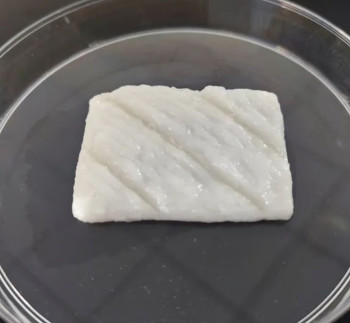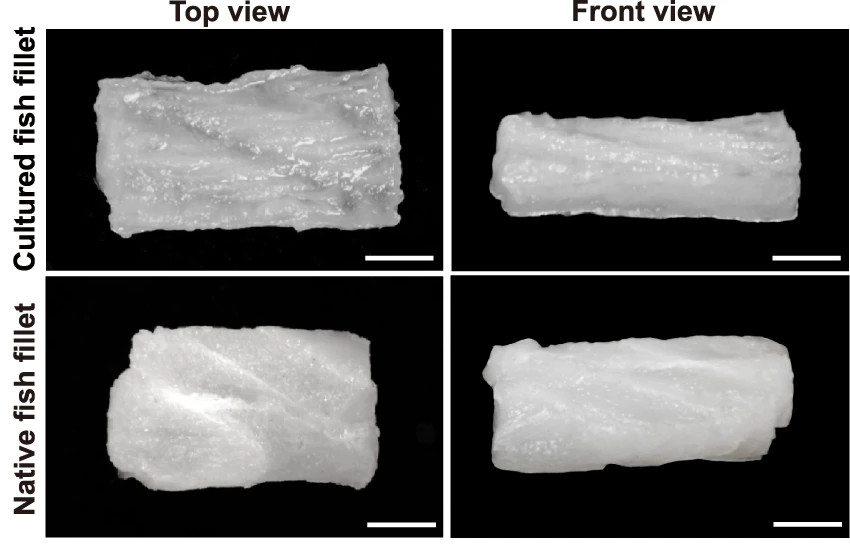|

Image:| Interesting Engineering / FIS
Lab-grown fish fillets promise to save yellow croaker fish from extinction
 CHINA
CHINA
Wednesday, May 24, 2023, 07:10 (GMT + 9)
Lab-grown fish fillets has the potential to satisfy the hunger of seafood lovers and save marine animals from the dangerous effects of overfishing.
 FIS Seafood Media.jpg) Yellow croaker (Larimichthys crocea) is a marine fish popular in many East Asian countries for its flavorful taste and high nutritious value. Unfortunately, the popularity of this fish is also causing a rapid decline in its population. Yellow croaker (Larimichthys crocea) is a marine fish popular in many East Asian countries for its flavorful taste and high nutritious value. Unfortunately, the popularity of this fish is also causing a rapid decline in its population.
It is currently labeled as critically endangered, and scientists warn that the decreasing population of yellow croaker is not showing any signs of recovery in many of its natural habitats. So will the world soon lose this beautiful fish to satisfy human taste buds?
A team of scientists from China’s Zhejiang University (ZJU) has proposed an interesting solution to this problem. They have created the first-ever lab-grown yellow croaker fish fillets that taste the same as their natural counterparts.

Representative images of cultured and native tissue fillets of large yellow croaker. Scale bar, 5 mm Source: Nature
Can lab-grown fillets replace real fish meat?
Besides its sweet taste, yellow croaker is known for its high protein, micronutrients, and omega-3 fatty acid concentration. Moreover, about 80 percent of the fish’s body mass is made up of fat and muscles. The Chinese researchers claim that their lab-grown fillet has similar nutritional value to a real croaker fish fillet.
When they compared the lab-grown fillet with the original fillets, they found that both had the same muscle-to-fat cell ratio, water percentage, and other physical attributes. However, the lab-grown fillets required less chewing when consumed.

Representative images of muscle fibers of native fish fillets and cultured fish fillets. Red: hematoxylin-eosin (HE) staining; SEM: scanning electron microscopy; Scale bar, 100 μm. Source: Nature
The researchers also detected noticeable differences in how water was distributed in their muscle cells. They hope to overcome such small differences with further research and believe, “This technology may provide support for addressing the supply of meat and animal protein for human beings.”
“It also has important implications for the conservation of marine fish stocks,” Liu Donghong, one of the study authors from ZJU, told SCMP.

So how did they create lab-grown fish fillets?
The study authors collected stem cells from a yellow croaker fish's muscle and fat tissues and cultured them in a medium. Initially, they noticed slow growth in muscle stem cells, so they studied different genetic pathways to trigger their growth.
They examined several factors that could affect the cells, “Among them, two signaling pathways, Notch and TGF-β, attracted our attention in particular. A balance between Notch and TGF-β signaling regulates the proliferation of satellite cells (give rise to skeletal muscles), and attenuation of TGF-β restores regeneration in old, injured muscle,” the researchers note.
When they inhibited both these pathways, the muscle cells in the culture also started growing and multiplying at a normal pace. The fish meat also began to take shape but even until this point it was loose. It lacked the tissue formation to be considered similar to real meat.

Average numbers of muscle cells and adipocytes in cultured fish fillets and native fish fillets with a size about 0.96 cm3. Error bars for three replicates indicated s.d.. NS: not significant. *P < 0.05. | Muscle and fat ratios in cell cultured fish fillets and native fish fillets. Error bars for three replicates indicated s.d. NS, not significant. *P < 0.05. Source: Nature
To provide the meat a proper structure and texture, the researchers shifted the culture into a 3D scaffold made out of satellite cells and gelatin-based gel. Finally, the fillets were ready,
The cell culture took 17 days to turn into real-like lab-grown fish meat. Hopefully, these lab-grown fish fillets will play a significant role in restoring the yellow-croaker population, and their success will also open doors to other kinds of lab-grown marine meat products.
Author: Rupendra Brahambhatt | Interesting Engineering
[email protected]
www.seafood.media
|



